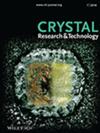偶氮嘧菌酯的多组分药物加合物:物理化学性质、热力学和分子模型研究
IF 1.9
4区 材料科学
Q3 CRYSTALLOGRAPHY
引用次数: 1
摘要
共晶剂作为一种廉价、环保且应用前景广阔的辅料,引起了人们的极大兴趣。为了提高偶氮唑的溶解度和溶出速度,采用旋转蒸发法制备了偶氮唑啉(AZO)与氟氧恶菌腈(FDO)、己二酸(AA)、琥珀酰亚胺(SIM)和2‐咪唑烷酮(IMD)共晶。差示扫描量热法和粉末X射线衍射法用于鉴别共晶。有趣的是,AZO与FDO、AA、IMD和SIM的化学计量比分别为7:3、7:3/8:2、7:3和6:4时先形成2型共晶。与偶氮共晶相比,这四种共晶在水中的溶解度和溶解速度都有所提高。分子动力学模拟表明,AZO与共构象分子之间形成了同源氢键,从而导致共晶区形成。同时,计算了四种共晶在这些可能的体系盒中,AZO与共晶之间的相互作用能。结果表明,AZO-FDO的相互作用能大于AZO-AA、AZO-SIM和AZO-IMD。本文章由计算机程序翻译,如有差异,请以英文原文为准。
Multicomponent Pharmaceutical Adducts of Azoxystrobin: Physicochemical Properties, Thermodynamic, and Molecular Modeling Study
Eutectics have invoked enormous interests as an inexpensive and greener excipient with promising applications. In this study, eutectics of azoxystrobin (AZO) with fludioxonil (FDO), adipic acid (AA), succinimide (SIM), and 2‐imidazolidinone (IMD) are prepared by rotary evaporation in order to improve the solubility and dissolution rate of AZO. Differential scanning calorimetry and powder X‐ray diffraction are used to distinguish eutectics. Interestingly, AZO forms form 2 at first and then forms eutectic at stoichiometric ratios of 7:3, 7:3/8:2, 7:3, and 6:4 with FDO, AA, IMD, and SIM, respectively. Compared with AZO, the solubility and dissolution rate of these four eutectics in water are improved. The molecular dynamics simulations between AZO and coformer molecules indicate that homologous hydrogen bonds are formed of conformer–coformer, which may lead to the formation of eutectic regions. Meanwhile, the interaction energies between AZO and coformers in these possible system boxes of the four eutectics are calculated. The results indicate that the interaction energy in AZO–FDO is greater than that in AZO–AA, AZO–SIM, and AZO–IMD.
求助全文
通过发布文献求助,成功后即可免费获取论文全文。
去求助
来源期刊
自引率
6.70%
发文量
121
审稿时长
1.9 months
期刊介绍:
The journal Crystal Research and Technology is a pure online Journal (since 2012).
Crystal Research and Technology is an international journal examining all aspects of research within experimental, industrial, and theoretical crystallography. The journal covers the relevant aspects of
-crystal growth techniques and phenomena (including bulk growth, thin films)
-modern crystalline materials (e.g. smart materials, nanocrystals, quasicrystals, liquid crystals)
-industrial crystallisation
-application of crystals in materials science, electronics, data storage, and optics
-experimental, simulation and theoretical studies of the structural properties of crystals
-crystallographic computing

 求助内容:
求助内容: 应助结果提醒方式:
应助结果提醒方式:


